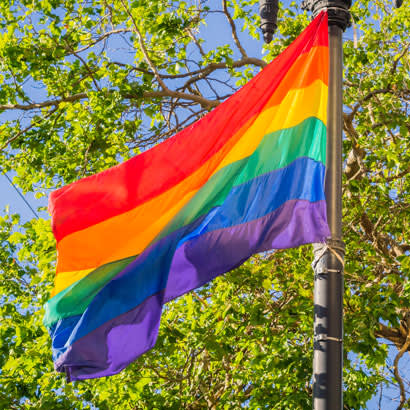
On June 28, 1969, police raided Stonewall Inn, a gay night club in New York City. This event, which became known as the Stonewall Riots, was a tipping point for LGBTQ (Lesbian, Gay, Bisexual, Transgender and Queer or Questioning) rights in the United States. It was regarded by many as the first major protest on behalf of LGBTQ equality in America, and the riots sparked the annual acknowledgement and celebration of LGBTQ Pride Month in communities across the county every June.
While the month is often celebrated with pride parades, picnics, parties, film festivals and memorials for lives lost to hate crimes or HIV/AIDS, the purpose of the commemorative month is much greater. Pride Month is a valuable time for all Americans to recognize the impact LGBTQ individuals have had on history, both nationally and across the world, and to acknowledge the adversity and challenges that continue to impact members of the LGBTQ community and their family and friends.
Although it’s been nearly 50 years since the Stonewall Riots, research shows that those who identify as LGBTQ often face health disparities, linked to societal stigma, discrimination, lack of physical and social activity opportunities, and continued denial of their civil and human rights. Social discrimination against LGBTQ persons has been associated with high rates of psychiatric disorders, substance abuse and suicide. LGBTQ youth are two to three times more likely to attempt suicide and 34 percent of LGBTQ youth report being bullied on school property.
A recent study also shows more teenagers are identifying themselves with nontraditional gender labels, such as transgender or gender-fluid, but those same teens reported having significantly poorer health, including mental health, than their peers. With these continued challenges facing members of the LGBTQ community, parks and recreation is well-suited to lead efforts that acknowledge these disparities, engage the community and enact policies and programs that provide safe and welcoming spaces and improve health and well-being.
The Gender Justice Project
Park and recreation agencies, like Seattle Parks and Recreation, are meeting the health, environmental and social needs of the local LGBTQ community by adopting policy, engaging those who identify as LGBTQ in planning efforts. The department also offers inclusive and targeted programs that provide increased opportunities for physical activity, outdoor experiences, social connections and healthy living. Seattle Parks and Recreation has long made LGBTQ inclusion and outreach a priority, investing in long-term, sustainable solutions to create a fairer, more socially conscious and just city.
At the policy level, the city of Seattle launched the Gender Justice Project in 2016. The Gender Justice Project is Seattle’s effort to create an inclusive workplace and city, seeking to end gender and race-based inequities in its workforce and in citywide policies, programs and service delivery, including parks and recreation.
As part of the Gender Justice Project, a citywide ordinance was passed to help achieve greater restroom access to transgender and gender-diverse individuals. In addition to the ordinance requiring the availability of single-occupant restrooms, the city is also investing internally in its workforce by providing the training and skills employees need to successfully work with community members who identify as LGBTQ.
Seattle Parks and Recreation invests in programming that is inclusive to all and explicitly states that those who identify as LGBTQ are welcome and encouraged to attend. Part of the department’s efforts include programs for those 50 years and older as part of its “Rainbow Recreation” initiative, hosting all-gender public swims, and providing safe, welcoming spaces and work opportunities for all teens, including those who identify as LGBTQ.
Creating More Accessible and Welcoming Spaces
In March 2018, Seattle Parks and Recreation held a summer job fair for LGBTQ youth, young adults and allies, connecting them to local employers who are LGBTQ-friendly. In addition to providing targeted and inclusive programming for LGBTQ individuals, there are some small steps that can be taken to create more accessible and welcoming spaces for all, including internally among staff. Consider enhancing your existing efforts by implementing some of the strategies featured in the new LGBTQ Inclusion in Parks and Recreation one-pager:
Messaging: It’s important to recognize that although spaces and programs may be open to all, members of the LGBTQ community may feel more comfortable when that message is explicitly stated and supported by staff. Consider adding messaging to promotional materials or displaying the messaging in the facilities to assure all community members that they are welcome.
Promoting Gender-Neutral Interactions: Train staff to use gender-neutral pronouns during interactions with all constituents to support an open environment. It is not possible to always correctly guess someone’s gender based upon the person’s name or their physical appearance. One way to prevent this mistake is by addressing people without using any terms that indicate a gender. For example, instead of asking, “How may I help you, sir?” simply ask: “How may I help you?”
Facility Improvements: Park and recreation agencies can add features to their facilities that aid in the comfort and increased safety for the LGBTQ community. These features include gender-neutral and/or unisex restrooms, private/family-style locker and changing rooms and identifying safe spaces for LGBTQ youth.
While many park and recreation agencies are already leading the way to more inclusive communities and providing health and wellness opportunities for all, there is more that can be done to ensure everyone feels welcome and accepted.
If your park and recreation agency is leading the way to a more inclusive community this June and beyond, share your story with us!
Allison Colman is a Program Manager at NRPA and identifies as she/her/hers.
References
1. LGBT Pride Month
2. LGBT Youth
3. CNN: “More US teens are rejecting 'boy' or 'girl' gender identities, a study finds”
4. All Gender Restrooms

